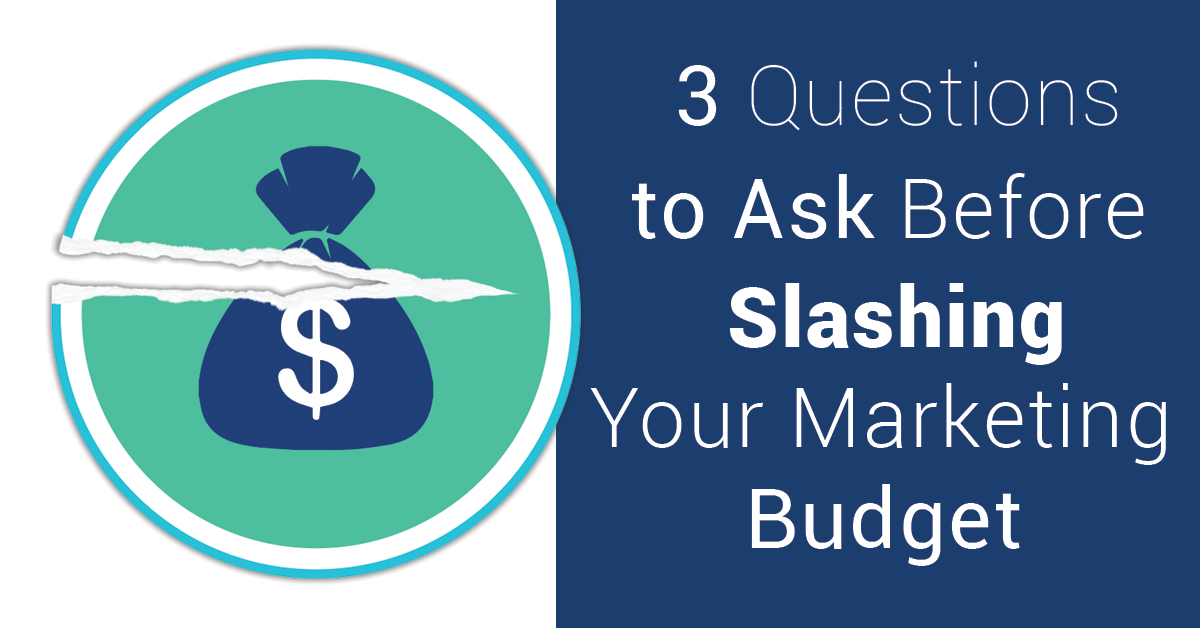3 Critical Questions to Ask Before Slashing Your Marketing Budget
This post was originally published in October 2020 and has been updated.
There are many different ways to trim your budget as you consider your business spending for 2022. While there may be certain cost-cutting measures you can take, however, your marketing budget should not be one of them.
Internet and social media usage continue to be at an all-time high, meaning you have an opportunity to reach customers who otherwise would never find you. Statista reports that usage continues to climb, with 82% of the U.S. population saying they currently use some form of social media.
Although the pandemic has brought about challenging times for businesses and consumers alike, it has also presented opportunities for businesses to grow. Rather than slash your marketing budget, ramp up your marketing efforts stay ahead of your competition.
According to Harvard Business Review (HBR): “Companies that have bounced back most strongly from previous recessions usually did not cut their marketing spend, and in many cases actually increased it. But they did change what they were spending their marketing budget on and when to reflect the new context in which they operated.”
As you finalize 2022 marketing planning, ask yourself these three critical questions. You might find that it’s simply a matter of reallocating your marketing dollars in new and better ways.
Related: The 6 Most Important Social Media Metrics to Track for ROI

By now, many businesses have already figured out how to pivot. There have been entirely new lines of business created, out of necessity:
Now is not the time to get comfortable. Keep the things that are working, but keep discovering ways to be better than your competitors, too.
As HBR puts it: “Research … shows that products launched during a recession have both higher long-term survival chances and higher sales revenues. That’s partly because there are fewer new products to compete with, but it also comes from the fact that companies maintaining R&D have focused the investment on their best prospects — which may explain why products introduced during recessions have been shown to be of higher quality.”
“A new and innovative product engenders hope that the economy is on the mend, and that the consumer may soon be able to afford it,” HBR adds.
It’s not enough to launch new products and services — how are you going to spread the word?
It’s essential that you pair your launches with strategic marketing plans for the greatest impact with your target audience.
Read more: Lessons Learned From the Pandemic: A Conversation With Franchisees

“Basically, share of voice helps you understand how popular your brand is compared to all your competitors,” adds SEJ.
Calculating your SOV requires a detailed explanation that goes beyond the subject matter of this article. The SEJ article referenced above offers a nice breakdown you can use to determine your own SOV. (Feeling acronymed out yet?)
However, the key takeaway is that increasing your advertising is a smart move right now while your competitors are cutting back. Think about it: As they decrease, and you increase, you gain more SOV.
“During recessions, when most firms are cutting back on their brand advertising, a firm’s share of voice increases if it can maintain or increase its advertising budget,” says HBR, citing Reckitt Benckiser, whose family of brands includes Clearasil, Durex, Woolite and, notably during the pandemic, Lysol.
“In the recession following the 2008 financial crash, the company launched a marketing campaign aimed at persuading its consumers to continue purchasing its more expensive and better performing brands, despite the harsh economic climate,” explains HBR. “Increasing its advertising outlays by 25% in the face of reduced marketing by competitors, Reckitt Benckiser actually grew revenues by 8% and profits by 14%, when most of its rivals were reporting profit declines of 10% or more. They viewed advertising as an investment rather than an expense.”
In today’s climate, gaining SOV means ramping up your marketing budget and advertising via social media and other digital mediums. Your followers need to hear from you, or they’ll forget about you and go elsewhere.
And even established brands need to work to stay relevant. Just look at big names like Coca Cola in 2020, reminding its customers that the brand “always has been, and always will be there for you, in good times and bad,” notes HBR. (Learn more in this YouTube segment.)
Your followers also need to see that you’re responsive to social media questions, comments, online reviews and other digital engagements. All of these small interactions add up to a greater SOV than the competitor with no social presence, unanswered comments and questions, and sometimes even reviews that haven’t received a response.
In summary, increasing your marketing budget has the potential to give you:
If you take a good look at where you are spending your marketing budget, you might find that you need to make some tweaks. If you’re spending money on pay per click but spending nothing on social media, for instance, you’re missing out on opportunities to reach your customer.
Learn more: 5 Ways to Integrate Email Marketing With Social Media Marketing

What kind of tweaks can you make?
Keep in mind that Rallio offers a variety of different products and services to help with your marketing goals. We’ll make things work for your particular marketing budget — so you can feel good about spending the money. Schedule a no-obligation consultation to find out how we can help.
There are many different ways to trim your budget as you consider your business spending for 2022. While there may be certain cost-cutting measures you can take, however, your marketing budget should not be one of them.
Internet and social media usage continue to be at an all-time high, meaning you have an opportunity to reach customers who otherwise would never find you. Statista reports that usage continues to climb, with 82% of the U.S. population saying they currently use some form of social media.
Although the pandemic has brought about challenging times for businesses and consumers alike, it has also presented opportunities for businesses to grow. Rather than slash your marketing budget, ramp up your marketing efforts stay ahead of your competition.
According to Harvard Business Review (HBR): “Companies that have bounced back most strongly from previous recessions usually did not cut their marketing spend, and in many cases actually increased it. But they did change what they were spending their marketing budget on and when to reflect the new context in which they operated.”
As you finalize 2022 marketing planning, ask yourself these three critical questions. You might find that it’s simply a matter of reallocating your marketing dollars in new and better ways.
Related: The 6 Most Important Social Media Metrics to Track for ROI

Have You Pivoted?
By pivoting, we mean changing course. Throwing your marketing dollars at the same things you were marketing heavily a year ago just doesn’t make sense. Instead, consider how your business can shift to address the current reality — now that we’re nearly two years into the pandemic.By now, many businesses have already figured out how to pivot. There have been entirely new lines of business created, out of necessity:
- Fitness studios, forced to close their doors due to COVID-19, had to launch virtual classes. Many of them are continuing these virtual offerings even as they reopen to cater to people who want to stay fit from home.
- Restaurants had to create takeout and delivery options.
- Retailers had to create ecommerce offerings in place of in-person shopping.
- Businesses that lost workers are now using social media to recruit new talent.
Now is not the time to get comfortable. Keep the things that are working, but keep discovering ways to be better than your competitors, too.
As HBR puts it: “Research … shows that products launched during a recession have both higher long-term survival chances and higher sales revenues. That’s partly because there are fewer new products to compete with, but it also comes from the fact that companies maintaining R&D have focused the investment on their best prospects — which may explain why products introduced during recessions have been shown to be of higher quality.”
“A new and innovative product engenders hope that the economy is on the mend, and that the consumer may soon be able to afford it,” HBR adds.
It’s not enough to launch new products and services — how are you going to spread the word?
It’s essential that you pair your launches with strategic marketing plans for the greatest impact with your target audience.
Read more: Lessons Learned From the Pandemic: A Conversation With Franchisees

Are You Satisfied With Your Share of Voice?
Share of voice (SOV) is a metric that describes your share of advertising compared to your competitors. It also includes all forms of measurable brand awareness, such as the number and reach of online mentions, pay per click, website traffic and other factors, says Search Engine Journal (SEJ).“Basically, share of voice helps you understand how popular your brand is compared to all your competitors,” adds SEJ.
Calculating your SOV requires a detailed explanation that goes beyond the subject matter of this article. The SEJ article referenced above offers a nice breakdown you can use to determine your own SOV. (Feeling acronymed out yet?)
However, the key takeaway is that increasing your advertising is a smart move right now while your competitors are cutting back. Think about it: As they decrease, and you increase, you gain more SOV.
“During recessions, when most firms are cutting back on their brand advertising, a firm’s share of voice increases if it can maintain or increase its advertising budget,” says HBR, citing Reckitt Benckiser, whose family of brands includes Clearasil, Durex, Woolite and, notably during the pandemic, Lysol.
“In the recession following the 2008 financial crash, the company launched a marketing campaign aimed at persuading its consumers to continue purchasing its more expensive and better performing brands, despite the harsh economic climate,” explains HBR. “Increasing its advertising outlays by 25% in the face of reduced marketing by competitors, Reckitt Benckiser actually grew revenues by 8% and profits by 14%, when most of its rivals were reporting profit declines of 10% or more. They viewed advertising as an investment rather than an expense.”
In today’s climate, gaining SOV means ramping up your marketing budget and advertising via social media and other digital mediums. Your followers need to hear from you, or they’ll forget about you and go elsewhere.
And even established brands need to work to stay relevant. Just look at big names like Coca Cola in 2020, reminding its customers that the brand “always has been, and always will be there for you, in good times and bad,” notes HBR. (Learn more in this YouTube segment.)
Your followers also need to see that you’re responsive to social media questions, comments, online reviews and other digital engagements. All of these small interactions add up to a greater SOV than the competitor with no social presence, unanswered comments and questions, and sometimes even reviews that haven’t received a response.
In summary, increasing your marketing budget has the potential to give you:
- Not just greater SOV, but also greater market share as a result of increased connections with customers and new prospects. Your social media ad campaigns, boosted posts and related email offers all help you reach your target audience.
- Retention of your core customer base. Staying top of mind means they think of you when they need your products or services. Out of sight means out of mind.
- New customers. How are you going to keep a constantly growing pipeline if you aren’t marketing and advertising yourself?
- A positive online reputation. Having someone dedicated to responding to every single social interaction and review is essential for cultivating credibility and trust with your target audience.
Can You Better Allocate Your Marketing Budget?
So if you aren’t going to cut your marketing budget, it makes sense to look at where you are spending your marketing dollars.If you take a good look at where you are spending your marketing budget, you might find that you need to make some tweaks. If you’re spending money on pay per click but spending nothing on social media, for instance, you’re missing out on opportunities to reach your customer.
Learn more: 5 Ways to Integrate Email Marketing With Social Media Marketing

What kind of tweaks can you make?
- Allocate money toward social media. Our research and firsthand experience with clients have demonstrated the value of social media marketing and advertising. Time and time again, we’ve seen that even a modest social media ad budget allows brands to extend their reach and expand their following. We are also actively helping our clients navigate iOS privacy concerns and changes to Facebook ad targeting options, which will become significantly reduced starting in January.
- Ensure your digital platforms are an extension of in-person experiences. Your social media messaging, design, visuals and even the people pictured in your local photos should reflect what you have in-store. Own a restaurant? They should see James, your head chef, and Sally, your hostess with the mostest.
- Provide a seamless shopping experience by aligning your social media with the rest of your marketing. For example, a shopper who shops in your physical store should be able to hop on your social media pages and have a similar experience. A shopper who receives marketing offers via email but isn’t targeted and retargeted via social media is a lost opportunity.
- Consider whether outsourcing would help you achieve more of your marketing goals with less money. The cost of hiring someone to manage the full-time job of social media marketing is often greater than the cost of outsourcing to a partner like Rallio.
Your Business Deserves a Smart Marketing Budget
We understand the current economic climate might make some businesses nervous about spending money on marketing. However, without a dedicated and properly allocated marketing budget, your business will have a tough time getting ahead.Keep in mind that Rallio offers a variety of different products and services to help with your marketing goals. We’ll make things work for your particular marketing budget — so you can feel good about spending the money. Schedule a no-obligation consultation to find out how we can help.



